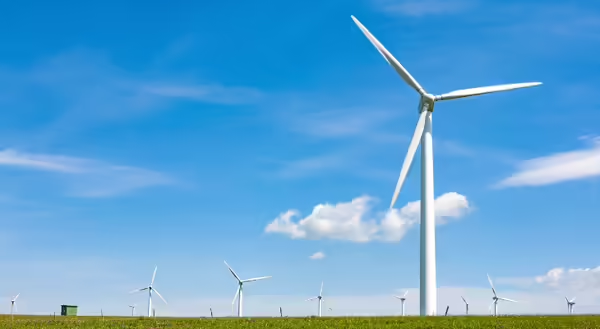
“It wouldn't be too bad outside if it weren't for the wind...”
What a wonderful Midwest saying as we are gearing up for the best season for wind. March is the windiest month of the year in Bloomington, with an average hourly wind speed of 12.6 miles per hour. Wind speed varies at a location based on topography, and there are significant seasonal variations over the course of a year. While high winds may be a nuisance at times, they are a strong source of renewable energy. In 2022, Illinois was ranked among the five states to generate the most electricity from wind alongside Texas, Iowa, Oklahoma, and Kansas.
How does wind energy work?
At a basic level, wind turbines have three parts including the tower, blades, and nacelle. The tower is a tall support structure that rises from the ground up into the air, while the blades are the three long pieces that rotate. The nacelle is located at the top of the tower and houses the generator, speed shafts, and other necessary parts.
Wind energy is a renewable energy source produced by moving air that turns the blades of a wind turbine. This rotational movement spins a generator, which then produces electricity. The process takes kinetic energy motion and converts it into electrical energy for electricity. The electricity generated can power specific needs or contribute to the electric grid.
Benefits to wind energy
Wind energy can be created as long as the wind is blowing. As a renewable source, we can utilize the wind without depleting the source. Our global rising population and increasing needs for energy are pushing us to new pathways of energy. An initiative by Standford University suggests nonrenewable natural resources such as oil and coal will run out by 2052 and 2090, respectively. On a global scale, utilizing renewable energy and being mindful of energy consumption will be key in the coming years.
Wind energy is also advantageous due to its flexibility in location. Wind turbines can be installed on land or offshore, which helps countries take advantage of wind currents along coastlines. Unlike fossil fuels such as coal and oil, which are mined in specific locations, wind turbines can be deployed in any area with open space and sufficient wind. Currently, there are distributed wind systems installed in all 50 states, and energy analysts predict a continued growth in wind development.
Wind turbines generate significantly lower levels of greenhouse gas emissions, which helps to decrease carbon dioxide emissions and overall pollution. Wind energy produces about 11 grams of carbon dioxide per kilowatt-hour of electricity generated, whereas coal produces nearly 90 times that amount.
Finding best practices
We utilize natural resources every day, and there will always be tradeoffs regarding which resources we need. The goal is to find solutions that give us the best benefits with the lowest amount of environmental impact. Energy analysts predict wind energy will continue to grow, strengthening the development of better wind energy technologies and increasing our use of renewable energy sources. This month, let the wind remind us of how far we have come in developing new pathways for energy and how we can continue to care for our environment.
Related Resources:
Reference: